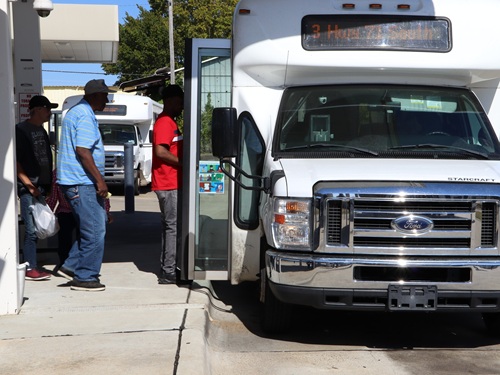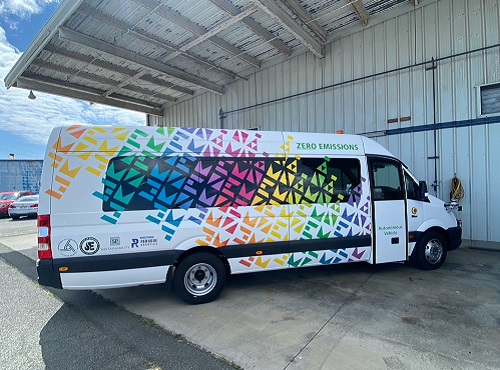At the 2023 annual meeting of the Western Association of State Highway and Transportation Officials, known as WASHTO, the Hawaii Department of Transportation rolled out its very first autonomous all-electric passenger shuttle bus.
[Above photo by Hawaii DOT]
Developed in collaboration with the University of Hawaii at Mānoa, the AV Star All-Electric Autonomous Min-E Bus is an Americans with Disabilities Act-compliant vehicle that can hold 14 passengers or 10 passengers and two passengers in wheelchairs. The vehicle is also equipped with the Perrone Robotics “TONY” system – short for “To Navigate to You” – autonomous system that Perrone said meets all Federal Motor Vehicle Safety Standards.
The agency added in a statement that this vehicle will also be the first to take advantage of Hawaii’s two-year old Autonomous Vehicle Testing law, meaning it can be tested on public roads.
Hawaii DOT said vehicles equipped with automated systems can ultimately lessen the number and severity of crashes, saving lives and reducing serious injuries. As the state moves toward electrifying its motor vehicle fleet by 2035, this pilot program will also provide the agency with valuable information regarding all-electric fleet operations.
The fleet vehicle is expected to serve as part of the Rainbow Shuttle service to transport students and staff around the Mānoa campus in Phase I, and then provide customized mobility-on-demand services in East Kapolei communities in Phase II. In addition, the university’s College of Engineering is collecting data to develop an analysis on the vehicles for Hawaii DOT.
Enabled by vehicle automation and connectivity enhancement, this pilot autonomous shuttle bus project provides first-hand experience and invaluable understanding of near-future transportation system operations. It will help the state better prepare for the upcoming vehicle-infrastructure-autonomy integrations, the agency said, as well as with large-scale autonomous vehicle deployments in Hawaii.
Compared to a gas-powered transit van, Hawaii DOT said this all-electric shuttle bus has the capacity to save more than 660 gallons of gas per year (roughly $3,133 savings/year in cost of fuel at $4.60 per gallon) and decrease carbon dioxide by 13,021 pounds per year.
Many other state departments of transportation have been conducting similar autonomous bus tests. For example, in January, the Pennsylvania Department of Transportation participated in an autonomous transit vehicle test in Philadelphia, along with researchers from Drexel University and consulting firm AECOM.
Also, in August 2022, the Minnesota Department of Transportation helped launch a free, low-speed, driverless, all-electric, multi-passenger shuttle service called “Bear Tracks” for the city of White Bear Lake.
Meanwhile, in March 2022, the North Dakota Department of Transportation issued funds to support a range of autonomous systems research aimed at helping the agency develop and maintain the state’s transportation system.
And in April 2021, the North Carolina Department of Transportation and the National Park Service conducted a three-month pilot test of a self-driving shuttle bus at the Wright Brothers National Memorial in Kill Devil Hills.
 States
States
Nick Donohue Appointed Virginia’s Secretary of Transportation
December 12, 2025 States
States

